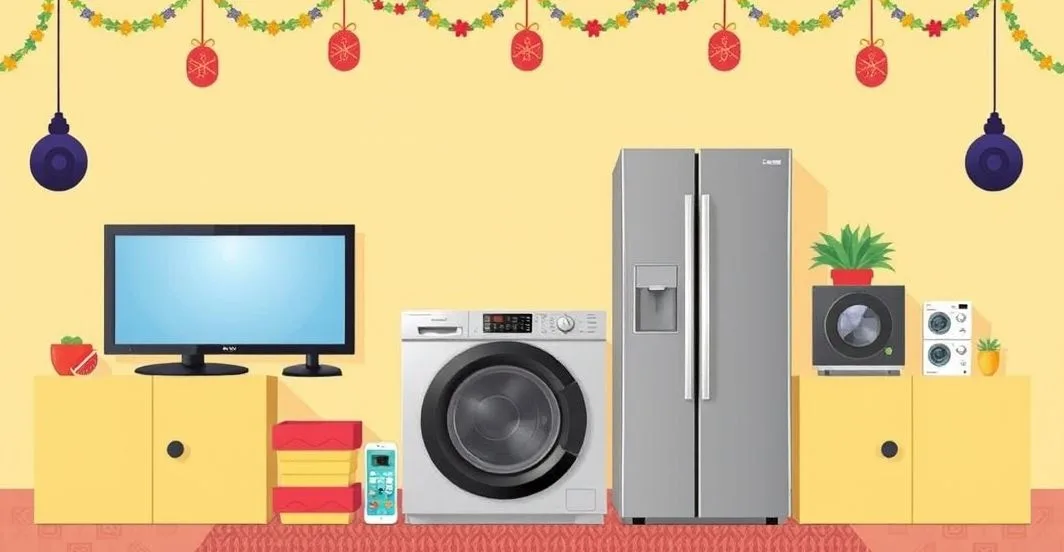Auto-published by Growwh – a smarter way to scale content and marketing. Want to know more? Chat with us.
GST rate cuts combined with early festive-season offers drove strong demand for consumer electronics, appliances and mobiles. First-week festive GMV surged, premiumisation accelerated, and sellers passed on savings—boosting categories like TVs, ACs, dishwashers, inverter batteries and premium TVs.
Festive season surge: GST reforms meet big-ticket demand
The latest festive season proved highly promising for consumer electronics and appliances as two powerful forces converged: a GST rate cut that reduced prices on many high-ticket items, and deep discounts from major ecommerce sales events. This combination triggered front-loaded buying by subscription shoppers and strong traction among mainstream consumers, leading to notable year-on-year growth across the sector.
Ready to take your brand to the next level?
At Growwh, we help startups and emerging brands grow faster with powerful content, creator collaborations, and tech solutions.
Explore what we do →
Key numbers at a glance
- Appliances GMV growth: 34% year-on-year
- Consumer electronics GMV growth: 41% year-on-year
- First-week festive GMV: ~Rs 6,000 crore, representing 51% of projected festive season sales and a 29% rise from last year
- Share of total festive GMV: Appliances, consumer electronics and mobiles comprised 64%
- Premium-product demand: ~26% year-on-year increase
- Premium TVs (QLED, Mini-LED): >23% year-on-year growth
- Inverter batteries: 2x jump in sales during the opening two days of the sale
What changed: GST rate cuts and timing
New GST reforms that took effect from September 22 shifted many consumer electronics and white goods from the 28% tax slab to the 18% slab. Items such as televisions, air conditioners and dishwashers became cheaper as a result, creating immediate price reductions just as ecommerce platforms kicked off their marquee festive sales.
Why ecommerce benefited
Ecommerce marketplaces offered early access to paid subscribers on September 22, enabling high-intensity shoppers to buy immediately and lock in combined savings from GST-driven price falls and sale discounts. This front-loading of demand contributed materially to the strong opening-week GMV numbers.
Category winners and consumer preferences
Several categories outperformed, driven by value-conscious buyers who also showed a preference for premium and energy-efficient options:
- Air conditioners and dishwashers: Double-digit year-on-year growth observed during the initial sale days
- Inverter batteries: Surged 2x as buyers reacted to lower prices and reliability concerns
- Premium refrigeration and laundry: Side-by-side refrigerators and advanced washing machines saw above-average demand
- Energy-efficient appliances: Split ACs, energy-efficient fans and air fryers became preferred picks
- Premium TVs: QLED and Mini-LED models gained strong traction, growing over 23% year-on-year
How sellers and marketplaces responded
Marketplaces and sellers publicly reported passing on GST benefits to customers through dedicated storefronts and targeted promotions. Sellers used the tax cut as a promotional lever, amplifying discount messaging to drive conversion during the busiest retail window of the year.
What this means for manufacturers, retailers and shoppers
- Manufacturers: Expect continued appetite for premium SKUs and energy-efficient models. Product roadmaps and inventory planning should prioritize high-margin premium offerings and after-sales support for larger ticket goods.
- Retailers & marketplaces: Early-bird promotions for subscription members can front-load demand and improve cash flows. Transparent communication about tax-driven savings fosters trust and conversion.
- Shoppers: The combination of GST rate cuts and festive discounts offers a rare chance to buy upgraded, energy-efficient appliances at lower effective prices—especially on high-ticket items that previously sat in the 28% tax slab.
Practical tips for buyers this festive season
- Compare final prices after factoring in the GST-reduced rate and marketplace discounts rather than only headline discounts.
- Look for energy-rating labels (star ratings) on ACs, refrigerators and washing machines to calculate long-term savings.
- Consider premium variants (QLED, Mini-LED TVs; inverter-equipped ACs; advanced washing machines) where the incremental performance and energy savings justify the higher upfront price.
- Check warranty, installation and after-sales service terms before buying high-ticket appliances online.
- If you’re a frequent shopper, paid early-access plans can yield meaningful savings during peak sales days.
Bottom line
The intersection of GST reforms and the festive sales calendar created a favorable environment for consumer electronics and appliances, driving strong GMV growth and accelerating premiumisation trends. For consumers, this translated to better value on large purchases; for the industry, it signaled a robust demand cycle for high-ticket, energy-efficient and premium products that could shape inventory and marketing strategies for the months ahead.
This article was auto-generated as part of a smart content campaign. Curious how we do it? Chat with us to learn more about our content automation systems.
Discover more from Growwh
Subscribe to get the latest posts sent to your email.


